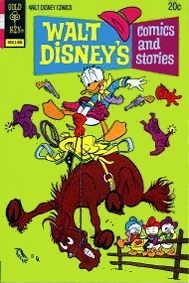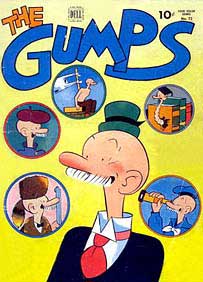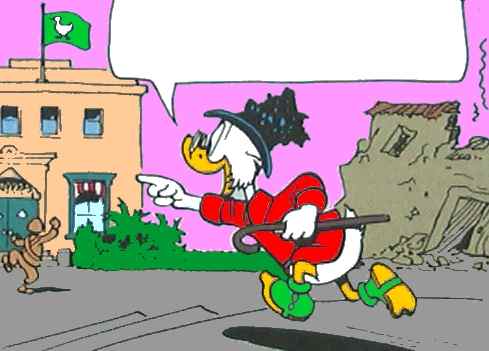| Of
course, Barks never hinted where Duckburg
was situated but he did reveal that the
town was in the state of Calisota (a
contraction of California and Minnesota).
Based on 'hints' from his stories, Don
Rosa and the Italian Donaldists find that
they have got sufficient material to
pinpoint Duckburg on a map. The site
equals Barks' homelands in Oregon! |
|
| Fan Malcolm Willits had
discovered Barks' identity in 1957 but he
did not actually contact Barks until 1960
because he was in the army at the time. |
|

Garé Barks actually drew
one front cover for Western. It happened
in WDCS405 and showed
Donald riding - well above - a wild
horse, and it was her husband who came up
with the idea. Later, he made a painting
of the idea. |
|
| Barks avoided political
issues in his comics. Although he had
strong opinions himself, he felt kids
were not interested in politics. |
|
| Barks is one of the very few
comic book artists who is read equally by
children and adults. |
|
| Like Fulldrip Pulpbugle in
WDCS188, Barks had severe bouts with hay
fever. He claimed his nose would swell up
like a red balloon. |
|
| When Barks invented Gyro
Gearloose he was only supposed to be an
occasional character in the stories.
Later, when the character became
enormously popular, Barks expressed his
vexation that he had not drawn him in a
simpler way, i.e. without hair, hat,
spectacles and waistcoat. |
|
| Due to his many allergies
Barks never kept pets. He said he liked
dogs, though, particularly huskies with
their expressive faces. He drew them in
several stories, always managing to
capture their unique, humorous, husky
personality. |
|
| In 1960 Barks reached an
unprecedented career record as he
produced 358 comic pages, 294
manuscripts, 15 front covers, and 4 ideas
for same. |
|
| In the 1940s Barks drew the
cartoon character Droopy after a
modelsheet which did not tell the dog's
name. He then named his comic book hero
Happy Hound. |
|
| Barks was one of the very
few artists at Disney's who both wrote
and drew his own stories. Another one was
the Mickey Mouse artist Floyd Gottfredson. |
|

It is well known that Barks modelled
Uncle Scrooge partly after Ebeneezer
Scrooge in Dickens' Christmas
Carol.
But he also used Sidney Smith's character
Uncle Bim from the Gumps daily strips
which premiered in 1917. Furthermore, he
- by his own admission - fashioned the
duck after himself... |
|
| Barks never saw his original
comic book drawings again after he
delivered them to Western for printing.
He always thought that they filed them,
but in fact they just threw them away!!! |
|
| Barks never had any trouble
with the fact that he was unknown to the
readers of his Disney stories. He once
stated that if his identity had been
revealed earlier, he would not have had
the necessary time to make stories. |
|
| In the beginning of his
comic book career Barks had to buy his
own drawing paper. |
|
| Carl
Barks' comics had about 10 million
American readers during the 1950s. |
|
| Barks only drew Ludwig van
Drake once. It happened in a U$54
one-pager. |
|
| In the early years of his
comic book life Barks was often insecure
about his work. Sometimes he looked upon
himself as 'a failed chicken farmer'. |
|
In FC0422
The Gilded Man Barks placed his
ducks in British Guiana to enable them to
meet El Dorado, the legendary figure of a
gilded man. However, Barks was mistaken
when assuming that the figure - which was
said to be the leader of the Chibcha
Indians - was from the modern British
Guiyana; the figure is supposed to come
from Guiyana, an enormous area which
originally covered all of the northeast
South America from coast to coast.
|
|
According to Garé
her husband was generally disappointed
that he was not allowed to sign his
stories. From time to time he would sneak
in his signature or other means of
identification, but the attempts were
always discovered by Western and removed
before printing.
|
|
| The story U$71 King
Scrooge the First, which Barks
only scripted, is 21 pages long. Still,
Barks got paid for 24 pages by mistake. |
|
|
| According to Barks himself,
he reached his artistic peak in 1949. It
was the year of (among others) Lost
in the Andes and Luck of
the North. |
|
| Barks only produced two
works with Mickey Mouse; the comic book
story The Riddle of the Red Hat
in FC0079 and the front cover for WDCS296. |
|
| Most of the stories sprung
from a desire to draw a specific locale -
a forest, a sea, a cave or whatever. Then
Barks evolved a story around the theme. |
|
| Barks used to go to the drug
stores in an attempt to see who actually
bought his comics. But never once did he
witness a kid buying one of his creations.
They were always choosing Superman or
Oswald the Rabbit. |
|
| Carl Barks used a well-known
technique which is not always recognized
by the reader. When drawing his ducks he
usually took out a piecut shape from
their eyes in the opposite direction of
where they were looking. In that way the
characters' eyes would look more alive
and shining and it was also easier to
understand what they were looking at. |
|
| In the 1940s Barks only saw
comic books as a passing fad of no real
value. |
|
| In WDCS104
Barks had Donald Duck invent a method to
raise a sunken ship by using lots of air-filled
Ping-Pong balls. The idea was used in
real life when a freighter carrying 6,000
live sheep sank in Kuwait's harbour in
1964. The Danish engineer Karl Kroyer
pumped 27 million Ping-Pong balls into
the hull of the ship, and it surfaced. |
|
| At one time, when Barks was
employed by Western, he was asked to draw
a variety of characters outside his duck
universe. He did it - reluctantly - with
his usual skill except for one character,
Bugs Bunny. Barks was simply not able to
draw the rabbit's facial expressions
satisfactorily, and other artists had to
redraw them afterwards. |
|

In 1950 Barks drew his story WDCS127
'April Foolers'. On the first
panel of the second page there is a book
with a cover reading Mein Kampf.
This is a book by Adolf Hitler, the
initiator of the Second World War. Carl
Barks put this book on the trash dump to
make a statement about Hitler who belongs
in the lowest of places - the trash. This
is the only instance where Barks made a
direct political statement in his comics. |
|
| Generally the comic stories
containing Grandma Duck's Farm Friends
and Daisy Duck's Diary were only drawn by
Barks. He regarded the work as a nice
break because it meant easy money, and he
did not have to do the writing which was
not that well-paid anyway. |
|
| Donald Duck's beak changed
appearance over the years. Its length
depended to a great extent on other
people's opinions. |
|
| The first time Carl Barks'
work as a Disney artist was publicly
recognized was in 1955 in a magazine
named Fortnight. In the article Charles
Beaumont called him 'The Dalai Lama of
Scripsters'. |
|
| Barks liked drawing front
covers because they paid 50 dollars -
better than story pages at 34 dollars. |
|
| Barks always thought of his
ducks as some sort of human beings which
in one incident might have caused some
confusion for his readers. He later came
to think that the Scrooge story Only
a Poor Old Man should have been
titled Only a Poor Old Duck. |
|
| Barks always finished one
story before even beginning to think of
the next. He could not concentrate on
more than one story at one time. |
|
| It is common knowledge that
Barks recycled some of his ten-pagers.
This was done for two reasons; because
Barks was pressed for time on deadlines
and hadn't sufficient time to dream up
new ideas, and because Western in fact
encouraged him to do so. They thought
that some of the old stories were far too
good to bury, and that new kids were
growing up all the time, and they would
not have any knowledge of the first ones.
Obviously, they did not think of
collectors! |
|

In U$64
Treasure of Marco Polo Scrooge
is attempting to hide in the Duckburgian
embassy while in Unsteadystan.
Apparently, Barks considered Duckburg to
be a city state, because the official
building is flying its own flag, a
rendering of a duck. |
|
| Barks was a smoker for many
years, but he managed to quit the habit
before his retirement. |
|
|